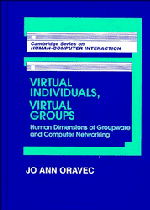Book contents
- Frontmatter
- Contents
- Dedication
- Overview
- Introduction
- 1 Evolution of computer application genres: Groupware and other network-based system applications
- 2 On the infinite variety of virtual entities
- 3 The shape of groups to come: Efforts to define, label, explain, and model collaborative activity
- 4 Shared resources and spaces: Lessons from the use of desks, tables, whiteboards, office settings, and video
- 5 Cultural objects and technological dreams: Dependence, autonomy, and intellectual augmentation
- 6 Privacy, anonymity, and agency: Applications of computer networking and the development of social analogues
- 7 Toward a genre-responsive design approach for computing applications
- Bibliography
- Author index
- Subject index
1 - Evolution of computer application genres: Groupware and other network-based system applications
Published online by Cambridge University Press: 05 August 2011
- Frontmatter
- Contents
- Dedication
- Overview
- Introduction
- 1 Evolution of computer application genres: Groupware and other network-based system applications
- 2 On the infinite variety of virtual entities
- 3 The shape of groups to come: Efforts to define, label, explain, and model collaborative activity
- 4 Shared resources and spaces: Lessons from the use of desks, tables, whiteboards, office settings, and video
- 5 Cultural objects and technological dreams: Dependence, autonomy, and intellectual augmentation
- 6 Privacy, anonymity, and agency: Applications of computer networking and the development of social analogues
- 7 Toward a genre-responsive design approach for computing applications
- Bibliography
- Author index
- Subject index
Summary
The word “genre” (originally from French, meaning “type”) is largely associated with the realm of literature. In that context it is usually employed to refer to generic varieties of written material, such as novels, poems, and short stories. Viewing a set of computer applications as a genre emphasizes commonalities and family resemblances among set members (although genres can occasionally include loosely knit, heterogeneous compilations, held together for reasons that are largely accidental and historical). Questions about the range of expression that genres afford, and of individuals’ rationales in their choices of genres, occupy the attention of many literary critics (for example, Banta, 1978; Todorov, 1990), media specialists, and active as well as prospective consumers of the genres.
Discourse on genre plays an important role in genre construction. Genre-related notions can be powerful tools for understanding a variety of phenomena associated with human expression. The document you have in your hands right now conforms to a certain set of standards for presentation. Some are set by the American Psychological Society (APA), whosePublication Manual is the generally accepted style book for many written works. Writing standards may seem arbitrary, a trivial nuisance one must put up with in one's journey toward self-expression and group expression. However, these standards serve considerable functions in the development and maintenance of academic disciplines. For example, the adherence to uniform standards of citation that the APA requires bolsters the prestige of psychology as both a profession and a research area, supporting the notion that authors are indeed building on the work of others and adding to the growing stock of knowledge of the discipline as a whole (Bazerman, 1987b).
- Type
- Chapter
- Information
- Virtual Individuals, Virtual GroupsHuman Dimensions of Groupware and Computer Networking, pp. 16 - 46Publisher: Cambridge University PressPrint publication year: 1996



